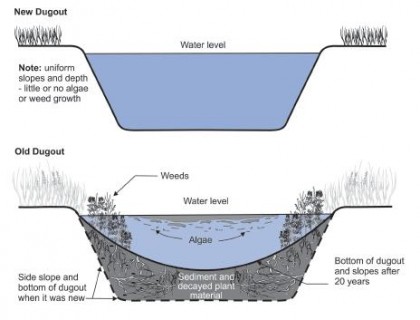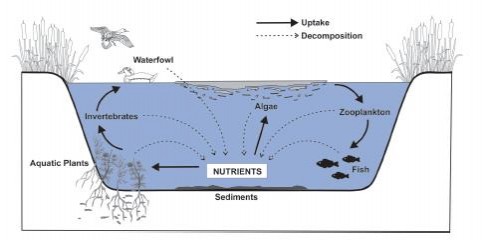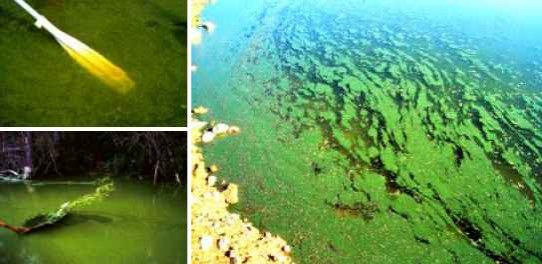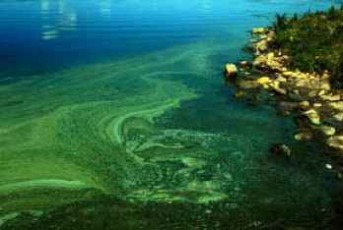One type of cyanobacteria is highly visible due to its "grass clipping" appearance with pieces measuring from 1/2 to 3/4 inch in length.Many people see a dugout as a stagnant, lifeless body of water. Nothing could be further from the truth. As a newly constructed dugout fills for the first time, it is quickly invaded by a variety of organisms, including plants, microbes, insects, and animals, and develops its own unique ecosystem. The fertile soils in which most dugouts are located contribute nutrients for plant growth. The rooted plants and algae represent an important food source for tiny animals called zooplankton. Through the food chain, the zooplankton become a source of food for insects that ultimately become a source of food for amphibians and fish. In fact, a dugout is a living ecosystem driven by natural cycles and processes.
The biology of a dugout is similar to the cycle within any other small body of water. Each summer, warm temperatures, and long sunny days produce an explosion of plant and animal growth. In daylight, plants consume nutrients and pump oxygen into the water; at night time oxygen production stops and respiration consumes dissolved oxygen which can result in low dissolved oxygen levels.. When they die, microorganisms decompose their tissues. This decomposition process consumes oxygen. On hot, still days biological activity is high and there is little oxygen added by wind-driven mixing of the water. In winter when the surface is sealed by ice, oxygen levels can also become very low. When this occurs, anaerobic organisms that do not use oxygen take over the decomposition process. Anaerobic activity releases many unwanted compounds into water. These include forms of iron and manganese that produce coloured water, and unpleasant smelling swamp gases, such as methane and hydrogen sulfide. As these microorganisms die, their decomposition also adds nutrients to the water body that become available to plants to begin the cycle again.
A dugout is a living ecosystem subject to natural cycles and processes
Many forms of plant life thrive in dugouts as shown in the figure. Some species are rooted in the dugout but are totally submerged. Others inhabit the margins where they are rooted in the sediments but hold their vegetation above the water. Cattails and reeds are examples of this type of plant. Although only one of the many forms of plant life in a dugout, algae get a lot of attention. This is primarily due to the problems they cause in a water supply. Algae can be present in dugouts but go unnoticed most of the time. When conditions are favourable however, they can reproduce very rapidly and cause a “bloom”. Algae blooms cause a variety of problems:
- Toxins in the water
- Water turbidity
- Tastes and odours
- Clogging of filters
- Ineffective disinfection treatment
- Formation of toxic chlorination by-products
- Fluctuating oxygen levels between day and night can result in fish kills.
Comment: Algae in dugouts are of particular concern with algae blooms causing several problems.
The formation of toxins by cyanobacteria is of the greatest concern. Some are capable of producing toxins that can damage the liver, nerves, lungs, and hearts of livestock. Cyanobacteria float near the water surface and wind action blows them to the side of the dugout. When livestock water directly at the edge of a dugout, they may be exposed to high concentrations of cyanobacteria in the water. Cases of livestock deaths due to cyanobacteria have occurred in all the Prairie Provinces.
Growth of cyanobacteria is greatest when the water is warm and concentrations of nutrients, especially phosphorus, are high. It is not easy to distinguish between cyanobacteria and harmless green algae. Positive identification requires training and use of a microscope. When an algae bloom occurs in water used for livestock, it is best to exercise extreme caution. Little corrective action is possible, once a cyanobacteria bloom has occurred. The most effective strategy for reducing the risk is to manage a dugout so the conditions that induce large populations do not develop. Much of this manual is devoted to this topic.
Duckweed is a readily identified oval shaped plant that floats on the water surface, and formsa mat that can cover the entire dugout
A much-maligned, but harmless plant called duckweed is sometimes confused with algae. It can be readily identified upon close inspection. Duckweed is an oval shaped plant that floats on the water surface. It can cover an entire water body with a green mat composed of millions of small plants. Duckweed can be beneficial in a dugout by preventing light penetration of the water and thereby shading out algae. It also takes up nitrogen and phosphorus from the water. Long-lasting benefit from duckweed is only realized however, if plants are removed before they die and the nutrients are released back into the water. To be successful the duckweed must be removed as often as once a month.
GreenAlgae
There are many types of green algae. Shown here is a filamentous type, which is characterized by long threads or filaments of cells attached together, and found floating as a mat on the surface. It is commonly called pond scum.
There are many types of Cyanobacteria. They are microscopic in size, but become visible when large populations develop forming what is termed a “bloom”. Some types are extremely toxic to humans and animals.
The Life Span of a Dugout
Like all man-made things, a farm dugout does not last forever as shown in Figure 2-8 New vs Old Dugout Cross-sections. All bodies of water, including farm dugouts, undergo a natural aging process. As the years go by, the dugout accumulates sediment from wind and water erosion. In some circumstances, an average sized dugout can collect more than 15 inches of sediment each year. This can total 50 tons or more. As the excavation fills with sediment, the holding capacity becomes greatly reduced. Some of the rehabilitation work on dugouts has shown that from 1 to 10 percent of water volume can be lost in a single year. Sediment also contributes nutrients that rapidly accelerate the natural aging process by increasing plant growth and lowering water quality.
One type of cyanobacteria is highly visible due to its "grass clipping" appearance with pieces measuring from 1/2 to 3/4 inch in length.
As a dugout fills with sediment, water quality deteriorates. In addition to collecting water and sediment, dugouts are very efficient at trapping the nutrients deposited from runoff to the dugout. Year after year, the accumulation of these nutrients from runoff events, plus their continual re-cycling within a dugout, cause a steady increase in plant and algaeOldVSNew growth. This leads to an ongoing deterioration in dugout water quality. A shallow dugout also warms more quickly in the summer and cools more rapidly in the winter. Warm water encourages algae growth in summer. The winter ice layer leaves even less water available and concentrates salts and nutrients in a smaller volume of water.
 The actual life span of a dugout depends on the quality of water that is required for different uses. Drinking water must have low biological activity. Irrigation water must have low levels of soluble salts. The length of time that a dugout can sustain the required quality is dependent on land-use practices in the watershed and the actual management of the dugout. As dugouts age, lower water quality can be expected.
The actual life span of a dugout depends on the quality of water that is required for different uses. Drinking water must have low biological activity. Irrigation water must have low levels of soluble salts. The length of time that a dugout can sustain the required quality is dependent on land-use practices in the watershed and the actual management of the dugout. As dugouts age, lower water quality can be expected.
In general, a farm dugout provides good water quality for about the first five years. Over the next ten years, storage capacity and water quality deteriorate. After 20 years, storage capacity and water quality have usually been reduced to the point where the dugout no longer meets the needs of the landowner. Regardless of its uses, the life span of a dugout can be extended significantly through effective management.
New vs. Old Dugout Cross-Sections
As a dugout fills with sediment, water quality deteriorates.




